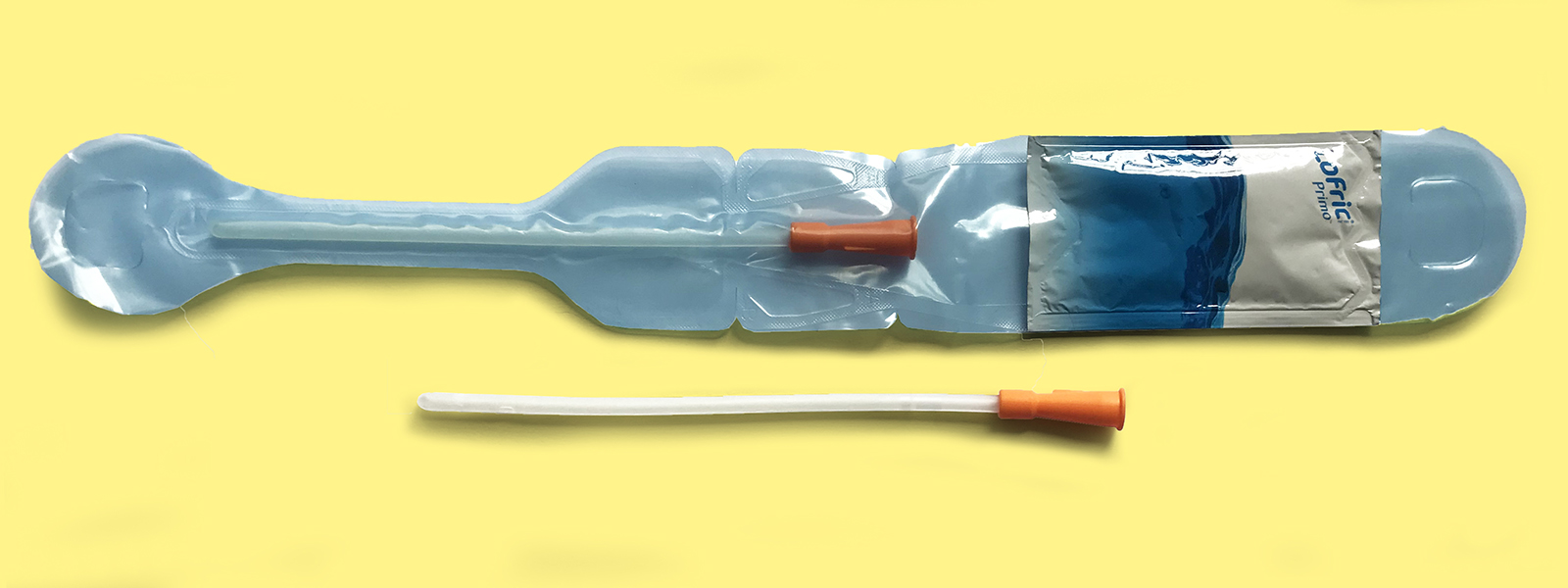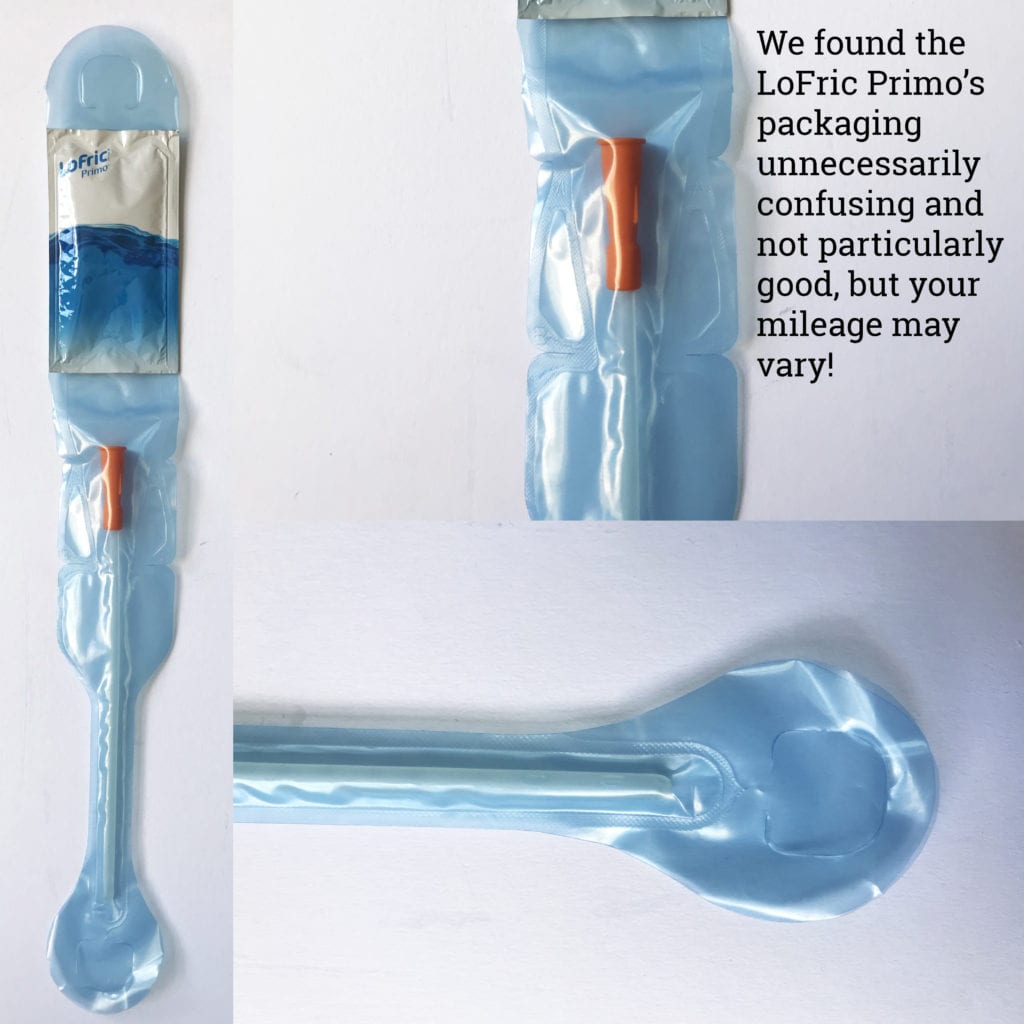Wellspect® LoFric® Primo™

Product Overview
Available Lengths: 15.75 inches (Male), 8 inches (Female) 7.87 inches (Pediatric), 6 inches (Female)
Available French Sizes: Fr 8, 10, 12 (Male & Female only), 14 (Male & Female only), 16 (Male & Female 6” only), 18 (Male & Female 6” only)
Available Tips: Straight and Coudé
Pros
The packaging allows you to choose your own adventure as far as opening the product goes (but can be pretty confusing as a result). That can be really helpful for limiting how much the catheter is exposed to pathogens.
An extremely lubricious catheter that’s also stiff will help make insertion easy.
Our Verdict
It’s hard not to think that Wellspect may have overthought their packaging design here. That being said, this catheter is popular for a reason – it’s quite the lubricious catheter, with the stiffness to make insertion a breeze.
Cons
This packaging design is just so confusing.
Popping the sterile water sachet can require a decent amount of strength.
The sachet of sterile water will sometimes not pop all the way – and whatever remains in the packet may get all over your clothes (it’s happened to us).
Material
The Wellspect® LoFric® Primo™ is a hydrophilic catheter made out of a material called polyolefin-based elastomer (POBE). Based on promotional material online, polyolefins generally exhibit good biocompatibility (meaning that it doesn’t harm living tissue). POBE is a catch-all term, however, so it’s hard to comment on the specific material used for this catheter.
The coudé-tipped version of the Primo™ is available in PVC as well, though details are light on the specific kind of PVC used. Given Wellspect®’s statements on all LoFric® products being manufactured without PVC, phthalates, and latex, it seems unlikely that the PVC version of the Primo™ would contain phthalates. Reports in the published literature note that use of PVC can be associated with negative health effects in humans and that its manufacture can be associated with negative environmental impacts.
The catheter is coated with a hydrophilic coating made out of salt and polyvinyl pyrrolidone (PVP). More on PVP below in the lubrication section!
Flexibility

Both the male and female versions of these catheters were among the stiffest that we tested. The male drooped down 7.5 inches while extending horizontally 10.75, whereas the female didn’t droop at all, despite extending 6.75 inches (making it longer than most other female catheters – though LoFric offers the female catheter in multiple lengths – an 8 inch and a 6 inch).
The stiffness of these catheters definitely makes them easier to insert and control. One drawback to a stiffer catheter is the possibility that its use can lead to urethral trauma (the study in question focuses on indwelling catheters, but the logic should hold for intermittent catheters).

Packaging
The LoFric® Primo™’s packaging can be pretty confusing…

Starting from the top of the packaging, you have easy-open tear holes that connect to a water sachet, but you’re not supposed to use these until you’ve already popped the water sachet. You do this by rolling the sachet down on itself several times before it finally pops, and then you let it drain down to the rest of the catheter and soak for 30 seconds. You’re now supposed to use the easy-open tear holes to open the package up and remove the catheter using the funnel, but we’ve had experiences where opening the sachet got the hydrating sterile water everywhere.
Alternatively, you can pop the sachet, let it drain down and soak, then invert the catheter so that the fluid flows back into the sachet, then use the easy-open tear holes towards the tip of the catheter to open the catheter and insert it. You just need to remember to open up the sachet end of the catheter (again, risking getting water over everything) so that urine can drain out of the catheter.
Or, you can pop the sachet, soak the catheter, then rip the sachet off the catheter where the packaging is marked A (this doesn’t have an easy-open feature), and then rip the packaging again where it is marked B by firmly gripping and twisting the packaging. You then remove the top and the bottom of the packaging and you’re left with a small flexible insertion aid, as well as a few dripping wet pieces of plastic that you’ll have to dispose of.
Of course, after doing this a couple of times, it shouldn’t be an issue to figure out a method that really works for you.
There’s also a sticky patch on the catheter packaging that’s ostensibly for sticking the catheter to a wall while waiting for it to soak and getting the rest of your catheterization supplies ready – but when we tried doing this, the catheter fell down because the patch wasn’t sticky enough.
Lubrication
PVP is the hydrophilic coating that gives this catheter its lubricious quality. PVP is generally considered to be safe, but can cause allergic reactions in rare cases – so check with your physician if you’re unsure as to whether or not this catheter is right for you. The sterile water included with the catheter does a good job of hydrating the catheter so that it’s easy to insert, but can get everywhere when opening the package so take care. When the catheter is hydrated, you’ll be able to feel a slightly textured surface on it, even with the lubricious coating. That being said, the catheter’s surface is really slippery due to the hydration, so it’s unlikely that this texture translates into an unpleasant insertion experience.
Wellspect uses its trademarked Urotonic™ Surface Technology on all of its LoFric® catheters. It apparently refers to the company’s efforts to match the salt content of the catheter’s surface to the salt content in urine, which helps the water on the catheter’s surface stay there throughout the entire catheterization procedure.
An academic study that aimed to develop a model that could be used to understand just how lubricious different urinary catheters are found two things of note. The amount of water found in the catheter coating did not impact how lubricious it was, and when analyzing lubriciousness as a function of how much force was required to insert and remove catheters, LoFric catheters exhibited some of the greatest lubricity in all catheters tested. The authors went on to conclude, however, that a different kind of catheter – the Aquacath (produced by Seton Continence Care, which doesn’t seem to exist anymore) “possess the most appropriate physicochemical properties for use in intermittent catheterization.
Insertion
Instructional videos from the manufacturer can be found here.
While the hydrophilic coating makes insertion of this catheter easier, the process of accessing the insertion sleeve really can be a pain. If you can open the water sachet, let the catheter soak, then tear off the sachet, drain the catheter, and open it inch by inch from the tip end as you insert it, you may be able to avoid contaminating the catheter with your hands. There will still likely be bacteria around the urethral opening, so you should swab it down with antiseptic wipes before inserting the catheter if you’re concerned about UTIs.

The insertion guide isn’t the most robust that we’ve seen in catheters of this type (the LoFric Origo, for example). The marketing materials also claim that the eyelets are smooth – the gold standard for smooth eyelets is the Cure Catheter®, and in comparison, the Primo®’s eyelets have fairly sharp edges, but are somewhat recessed compared to the rest of the catheter shaft.

Adverse Events
There were no complaints filed to the FDA about the LoFric® Primo™ catheter in 2019.

The review of FDA Medical Device Reports from 2019 provides a limited snapshot of recent product performance in the marketplace.